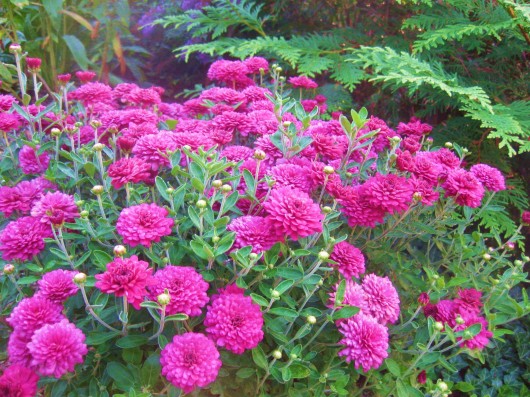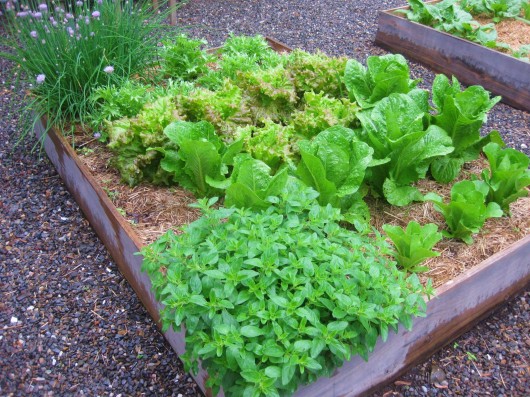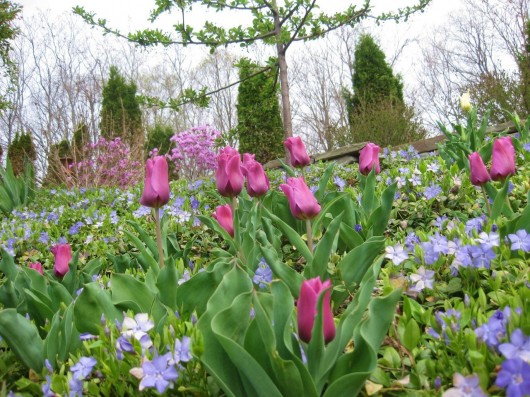This post was originally posted HERE.
I’D LIKE TO TELL YOU that September is a restful month. But alas, this is the time to divide and reset perennials, order and plant bulbs, set up a window garden, and prepare the vacationing houseplants for their return to indoor life. Feeling energetic? Good. You’ll reap great rewards later on if you accomplish the following now:
Bulbs. Order early, and with purpose. Print out a copy of your order form, and note each bulb’s height, color and location for planting. This way you won’t get caught — like I was, one year — standing in the cold with a bag of hyacinths and not the slightest clue where to plant them. (I always order extra tulips, daffodils, Dutch hyacinths and muscari for advance bloom in the house.) Here are my favorite bulbs for planting indoors and out.
 Chrysanthemums. If you don’t already have these in your garden, why not splurge on a few now? They do wonders for the September-to-frost border. Chrysanthemum ‘Helen’ (above), blooms year after year in my Serpentine Garden, just when other perennials are beginning to wane. If you don’t wish to plant the mums, just tuck pots beneath trees and between other plants for temporary decoration.
Chrysanthemums. If you don’t already have these in your garden, why not splurge on a few now? They do wonders for the September-to-frost border. Chrysanthemum ‘Helen’ (above), blooms year after year in my Serpentine Garden, just when other perennials are beginning to wane. If you don’t wish to plant the mums, just tuck pots beneath trees and between other plants for temporary decoration.
Iris. Divide and reset crowded clumps, but remember to keep rhizome tops exposed.
Lilies. After flowers fade, cut stems back to the ground. Don’t clip foliage until turns yellow and becomes loose.
 Peony. Divide and transplant any poor-blooming old plants or set out new ones this month. They need sun, good drainage and only two to three inches of soil over the crowns.
Peony. Divide and transplant any poor-blooming old plants or set out new ones this month. They need sun, good drainage and only two to three inches of soil over the crowns.
Roses. Keep deadheading, but stop feeding. Roses need to prepare themselves for winter dormancy — not new growth.
Vegetables
 Broccoli. If you’d like to freeze your autumn harvest, follow these directions.
Broccoli. If you’d like to freeze your autumn harvest, follow these directions.
Cabbage. Are slugs eating the leaves? Stop this destruction by spreading iron phosphate (sold as “Sluggo”) beneath the plants. By all accounts, iron phosphate is completely harmless to people and pets.
Carrots. Harvest what you need; leave the rest in the ground over winter. At the first spring thaw you’ll have some of the sweetest treats in the world. I speak from experience.
 Salad Greens. Continue sowing until October 1. If a sudden hard frost is predicted, and you don’t have a proper row-cover, just throw a sheet over the crop.
Salad Greens. Continue sowing until October 1. If a sudden hard frost is predicted, and you don’t have a proper row-cover, just throw a sheet over the crop.
Onions. Harvest, cure and store according to these directions.
Potatoes. Although my potato vines have died back, I certainly won’t harvest the crop until really cool weather arrives (usually the end of October). This way my cellar will be cold, too, and thus better suited for potato-storage. Tubers only keep well in quarters which are dark, humid, and chilly (35-40 degrees F.). How I plant, grow, harvest, and store potatoes.
Tomatoes. To avoid the ravages of late blight, frost, or a severe storm, pick mature fruits while they are still green, and let them ripen in paper bags indoors. I find that a banana placed in each bag really speeds things up.
Herbs. Not sure how to freeze or store your garden’s bounty? I handle matters this way.
Indoor Gardening
 Vacationing Houseplants. Gradually condition these to indoor life before nights get cold. By Labor Day, I move mine to the porch where there is less light than in the open and they stay there for a week or two. Prior to their coming in, pots should be scrubbed, foliage cleansed with a firm blast of water, and both pot and plant sprayed with a good insecticide (I use House & Garden Raid). This way, plants will be in a clean condition and no pest epidemics will start. Indoors, keep windows open day and night to provide plenty of fresh air through the first weeks. Then there should be a minimum of leaf-drop and general discontent with the home environment.
Vacationing Houseplants. Gradually condition these to indoor life before nights get cold. By Labor Day, I move mine to the porch where there is less light than in the open and they stay there for a week or two. Prior to their coming in, pots should be scrubbed, foliage cleansed with a firm blast of water, and both pot and plant sprayed with a good insecticide (I use House & Garden Raid). This way, plants will be in a clean condition and no pest epidemics will start. Indoors, keep windows open day and night to provide plenty of fresh air through the first weeks. Then there should be a minimum of leaf-drop and general discontent with the home environment.
 Design a Window Garden. Houseplants look their best, and are far easier to maintain, when you display them not just on a window sill, but in a real window garden. A window garden is an ordinary window that’s been outfitted with a broad sill and glass shelves. It takes neither money nor skill to create such decorative quarters for plants. Here’s proof.
Design a Window Garden. Houseplants look their best, and are far easier to maintain, when you display them not just on a window sill, but in a real window garden. A window garden is an ordinary window that’s been outfitted with a broad sill and glass shelves. It takes neither money nor skill to create such decorative quarters for plants. Here’s proof.
Petunias, Wax Begonias, Impatiens. Take cuttings now, and root them in pots of good soil. Brought indoors before frost, these tender annuals will provide cheerful bloom during the dark winter months.
Amaryllis. Induce dormancy the first week in September. To do this, lay the pot on its side and let the soil dry out. Remove the foliage after it turns yellow and becomes loose, and then bring the plant indoors to a dark and cool place. Give water not more than once every three weeks during the winter rest. Need more details? See my Amaryllis Growing Guide.
Is my monthly list of chores helpful to you in some small way? Perhaps you can let me know by leaving a comment.







Leave a Reply